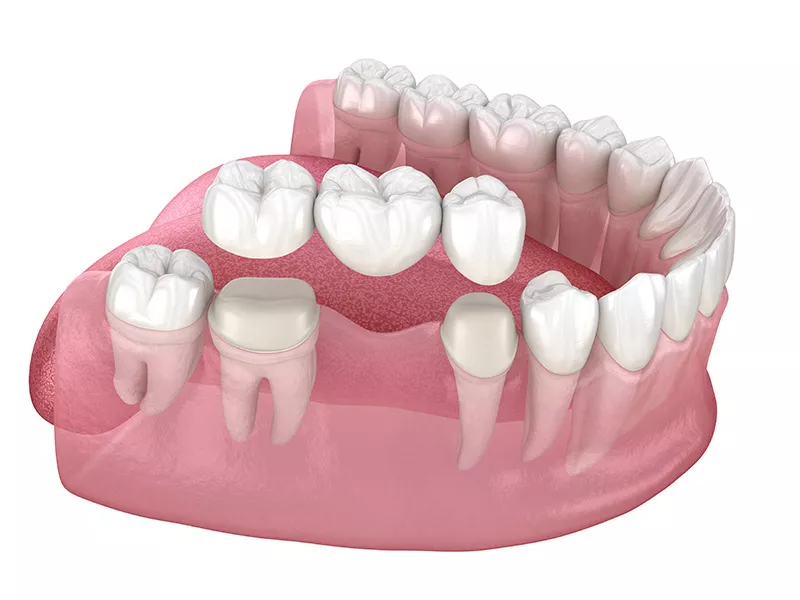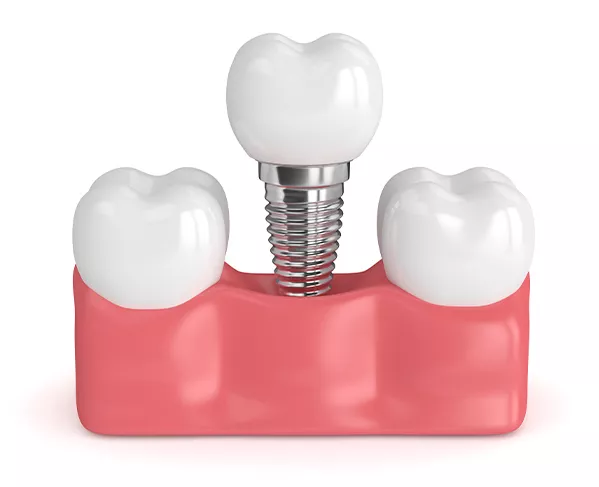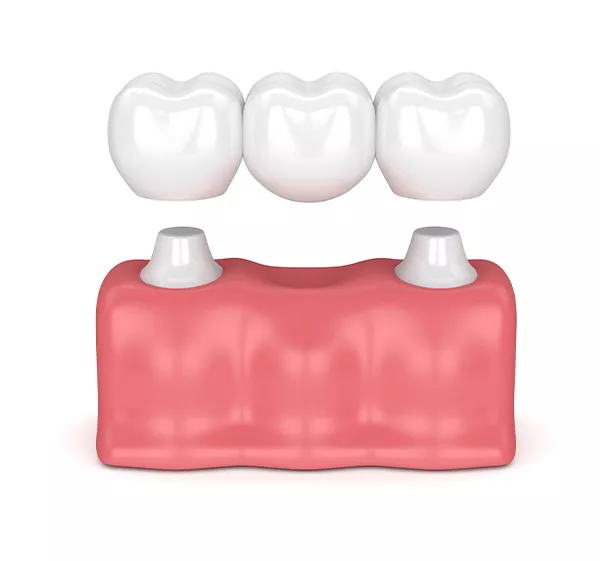What Is a Dental Bridge?
A dental bridge is a prosthetic solution used to replace one or more missing teeth. A bridge typically consists of two or more crowns placed on the abutment teeth (the teeth on either side of the gap), with one or more artificial teeth (pontics) in between. These artificial teeth can be made from metal, ceramic, or a combination of both.
Who Is a Dental Bridge For?
A dental bridge is intended for patients who are missing one or more teeth and are looking for a permanent solution to restore the function and appearance of their mouth.
Here are some situations where a dental bridge may be the right choice:
- Missing one or more teeth
- Aesthetic concerns
- The need for a functional tooth replacement
- Suitable for older adults looking for a stable, lasting solution
When Is a Dental Bridge the Right Choice?
Missing One or More Teeth
Bridges are ideal for individuals who have lost one or several teeth and want to avoid the problems that can arise from missing teeth, such as difficulty chewing, speaking, or aesthetic concerns.
Aesthetic Reasons
Some people choose a dental bridge to enhance the appearance of their smile, especially when the missing tooth is visible while speaking or laughing.
Need for Functional Replacement
Tooth loss can affect chewing and even the health of the jaw joint. A dental bridge offers a durable and functional replacement, allowing patients to chew normally again.
For Older Adults
While implants are often considered a more long-term solution, some older patients may opt for a bridge as a faster and less invasive alternative, especially if they are not ideal candidates for implants.

How a Dental Bridge Works
The principle behind a dental bridge is to create a “bridge” between existing teeth (or implants), which serve as supporting pillars for the artificial teeth.
Struktura
- Abutment Teeth: These are the teeth on either side of the missing tooth (or teeth) that act as supports. They are usually reshaped (filed down) to hold dental crowns.
- Crowns: These are placed over the abutment teeth and serve as anchors for the artificial teeth in the middle.
- Pontics (Artificial Teeth): These are placed between the crowns and fill the gap left by missing teeth. They can be made from a variety of materials, including porcelain, gold, alloys, or a combination of materials.
How Is a Dental Bridge Prepared?
Preparing a dental bridge is a complex process that requires multiple dental visits and may involve other specialists. Below is a detailed professional overview of each phase:
Consultation and Diagnosis
- Clinical Examination: The dentist performs a thorough evaluation of the oral cavity, including visual inspection.
X-rays: Panoramic or periapical X-rays help assess the condition of the jawbone and adjacent teeth, and determine whether the abutment teeth are suitable for supporting a bridge.
Assessment: Based on the findings, the dentist decides on the most appropriate type of bridge and materials to be used.
Preparation of Abutment Teeth
- Enamel Removal: A small portion of enamel is removed from the abutment teeth to make space for the crowns that will hold the bridge. This step is essential for stable attachment.
- Impression: Once the teeth are prepared, an impression is taken and sent to the dental lab. This serves as a model for crafting the bridge.
Temporary Protection
- Placement of a Temporary Bridge: A temporary bridge or crowns are placed over the prepared teeth to protect them and the surrounding gums while the permanent bridge is being made.
Bridge Fabrication
- Lab Work: Using the impression and the dentist’s specifications, technicians in the dental lab fabricate the custom bridge. This process may take several weeks.
Fitting and Adjustment
- Trial and Adjustment: Once completed, the bridge is tested before final placement. The dentist checks the fit, color, and bite alignment. Several minor adjustments may be needed.
- Cementation: After confirming a proper fit, the bridge is permanently cemented onto the prepared abutment teeth.
- Follow-Up Care: Follow-up visits may be scheduled to ensure proper function, comfort, and to address any complications.
Dental Bridge vs. Dental Implant
Choosing between a dental bridge and a dental implant is a key step in finding the best solution for replacing missing teeth. Each has its pros and cons, and the decision depends on individual needs, overall health, and financial considerations.

Dental Implant
- Structure: The implant consists of a titanium screw that is surgically placed into the jawbone. A dental crown is then attached to the implant.
- Durability: Implants are considered a long-term solution and can last a lifetime with proper care.
- Functionality: They offer a replacement that closely mimics a natural tooth in both function and appearance.
- Bone Health: The implant stimulates the jawbone, helping to prevent bone loss (resorption) in the area of the missing tooth.
- Cost: Implants are usually more expensive upfront than dental bridges, but they may be more cost-effective in the long run due to their longevity.
- Surgical Procedure: Placement requires minor surgery and generally involves a longer healing period.
- Limitations: Not suitable for everyone—particularly patients with insufficient jawbone or certain health conditions may not be candidates for implants.

Dental Bridge
- Structure: A bridge consists of two crowns for the abutment teeth and one or more artificial teeth (pontics) in between.
- Durability: Typically lasts 5–15 years, depending on the material used and the level of oral hygiene.
- Functionality: Improves chewing and speech functions, but does not stimulate the jawbone like implants do.
- Bone Health: Does not prevent bone resorption in the area of the missing tooth.
- Cost: Usually less expensive in the short term, but may require replacement or maintenance, increasing long-term costs.
- Surgical Procedure: No surgery is required—it’s generally less invasive than dental implants.
- Limitations: May require shaving down healthy adjacent teeth to serve as supports (abutments) for the bridge.
How to Decide Which Tooth Replacement Option Is Right for You
Choosing between a dental implant and a dental bridge is a personal decision. It’s essential to consult with a qualified dentist, who can help determine which solution is most suitable for you based on your overall health, lifestyle, and budget.
Advantages and Disadvantages of a Dental Bridge
A dental bridge is one of the most traditional methods of replacing missing teeth and comes with its own set of pros and cons.
Advantages
- Quick treatment: Unlike implants, which may take months to heal and place, a dental bridge can usually be completed in two or three visits.
- Lower cost: Bridges are generally more affordable than implants in the short term.
- Aesthetic results: Modern materials, especially porcelain, allow for natural-looking, attractive results.
- Functional improvement: Bridges restore the ability to chew and speak properly, which are often affected by missing teeth.
- Support for neighboring teeth: A bridge stabilizes adjacent teeth by filling the gap, preventing them from shifting.
- No surgery required: Unlike implants, bridges do not involve surgical procedures.
Disadvantages
- Loss of healthy tooth material: Supporting teeth often need to be shaved down to accommodate the bridge, which removes healthy enamel.
- Risk of decay and inflammation: Food particles and bacteria trapped under the bridge can lead to tooth decay or gum disease.
- Limited lifespan: Bridges typically last 5–15 years, depending on care and material.
- No bone stimulation: Bridges do not stimulate the jawbone, which can lead to bone resorption over time.
- Hygiene complications: Cleaning a bridge can be more difficult than cleaning natural teeth or implants.
- Possible future repairs: Wear, damage, or decay in supporting teeth may require repair or replacement of the bridge.
Every patient is unique, so it’s crucial to carefully weigh these pros and cons in the context of your own health, lifestyle, and financial situation. A qualified dentist can provide personalized advice and recommendations.
What Are the Risks of Using a Dental Bridge?
Dental bridges are a common and effective treatment, but like any medical procedure, they carry potential risks and side effects:
Cavities in abutment teeth
Even though these teeth are covered with crowns, poor oral hygiene can lead to decay beneath the bridge.
Gum problems
Inadequate cleaning around the bridge can cause gum inflammation, discomfort, swelling, and bleeding.
Damage to neighboring teeth
Weak or compromised abutment teeth may deteriorate over time due to added pressure.
Bone loss
Unlike implants, bridges do not stimulate the jawbone, which may lead to gradual bone loss.
Aesthetic issues
Over time, bridge materials may discolor or lose their shape. In some types of bridges, the metal framework may become visible.
Functional issues
A poorly fitting bridge may impair chewing, speech, or cause uneven wear on other teeth.
Mechanical damage
Bridges made from less durable materials may break and require costly replacement.
Allergic reactions
Though rare, some patients may react to the materials used in the bridge.
To minimize these risks, consult a professional dentist and undergo necessary diagnostic testing. Good oral hygiene and regular check-ups are essential for early detection and prevention of complications.
Types and Materials of Dental Bridges
Dental bridges come in various forms depending on the patient’s needs, oral health, and budget. There are three main types:
Traditional Bridge
The most common type, consisting of two crowns on either side of a gap and one or more artificial teeth (pontics) in between. Materials include porcelain, metal, or a combination of both.
Cantilever Bridge
Used when there are neighboring teeth on only one side of the gap. This bridge is anchored to one tooth and is less stable, making it unsuitable for high-pressure areas like the molars.
Maryland (Resin-Bonded) Bridge
A minimally invasive option that uses metal or porcelain wings bonded to the back of adjacent teeth. It doesn’t require tooth preparation but is also less strong and stable than traditional options.
Each type has its pros and cons, and the best choice depends on the location of the missing tooth, the condition of adjacent teeth, and the patient’s budget.
Lifespan of a Dental Bridge
A dental bridge can last between 10 to 15 years or more, depending on:
Placement
Bridges in the front of the mouth usually last longer than those in the back due to lower bite pressure.
Oral hygiene
Regular brushing, flossing, and dental check-ups significantly extend the bridge's life.
Lifestyle habits
Smoking and consuming stain-causing foods or drinks can affect the appearance and integrity of the bridge.
Care and Maintenance of a Dental Bridge
Proper care is essential to maintain the function and appearance of your dental bridge:
Daily cleaning
- Use a soft toothbrush and fluoride toothpaste at least twice a day.
- Use interdental brushes, floss threaders, or water flossers to clean under the bridge.
Special Care
- Superfloss or Flossing Under the Bridge: Some dental floss products have a stiffened end to help guide the floss under the bridge and a soft, spongy section for removing plaque and food particles. This is essential for maintaining hygiene beneath the pontic (artificial tooth).
- Antibacterial Mouthwash: These can help reduce the amount of bacteria in the mouth, but they should not replace mechanical cleaning with a toothbrush and floss.
Regular Dental Check-Ups
- During regular dental visits (typically every 6 months), your dentist will professionally clean and examine your bridge. They will also check the integrity of the bridge and supporting (abutment) teeth to catch any early signs of issues.
Be Cautious with Food
- Avoid hard, sticky, or crunchy foods that could damage the bridge. It's also wise to limit consumption of sugary snacks and drinks, which can contribute to tooth decay, especially around the abutment teeth.
Other Habits
- Do not use your teeth as tools—for example, to open bottles or cut objects—as this could damage the bridge.
While dental bridges are built to be durable, they are not indestructible and can wear down or break if not properly cared for. Maintaining good oral hygiene and regular dental check-ups is essential to maximizing the lifespan and performance of your dental bridge.
Cost of a Dental Bridge
The cost of a dental bridge depends on several factors and may vary accordingly. Below is a general overview of typical price ranges:
- Bridge to replace a single tooth: Usually ranges between CZK 5,000 and CZK 15,000.
- Bridge replacing two or three teeth: Typically costs between CZK 10,000 and CZK 30,000.
- Complex replacements involving four or more teeth or a full arch: The cost may reach CZK 50,000 or more.
These price estimates are illustrative only and may vary depending on the location, reputation of the dental clinic, type of material used, technologies involved, and the specific needs of the patient.
Please note that these estimates do not include additional costs, such as initial consultations, preparation of the tooth socket, X-rays, temporary prosthetic restorations, or follow-up appointments.
Therefore, it is recommended to consult a qualified dentist who can provide detailed information about the financial aspects and treatment options based on your individual case.
How Soon After Tooth Extraction Can a Dental Bridge Be Placed?
The timing for placing a dental bridge after a tooth extraction depends on several factors, including:
Condition of the Gums and Bone Socket
After extraction, the area must heal and the gums and bone need to stabilize. This healing process typically takes a few weeks to several months, depending on the individual.
Type of Bridge
Some bridge types, such as adhesive (Maryland) bridges, can be placed relatively quickly. Traditional or implant-supported bridges usually require a longer preparation period to ensure proper support and stability.
Overall Health of the Patient
Patients with good oral health and no complications generally experience faster healing and may be candidates for earlier bridge placement.
Dentist’s Professional Assessment
Your dentist will evaluate your condition and determine the best type of bridge and when treatment can begin based on clinical and diagnostic findings.
In some cases, a temporary bridge or denture may be used as a provisional solution while waiting for permanent restoration. This is often beneficial for aesthetic reasons or to restore chewing and speaking function during the healing period.
Your Reviews
The purpose of our work is your health
and a naturally beautiful smile
Our Clinic’s Equipment
Experience 21st-Century Aesthetic Dentistry
At Clinic for Smile, you are cared for not only by highly trained specialists but also with the most advanced dental technology, including a 3D X-ray and an intraoral scanner.
Additionally, there’s no need to worry about excessive pain. When necessary, we use local anesthesia to make your procedure as comfortable as possible. Visit Clinic for Smile and experience 21st-century aesthetic dentistry.
Let us take care of you.





